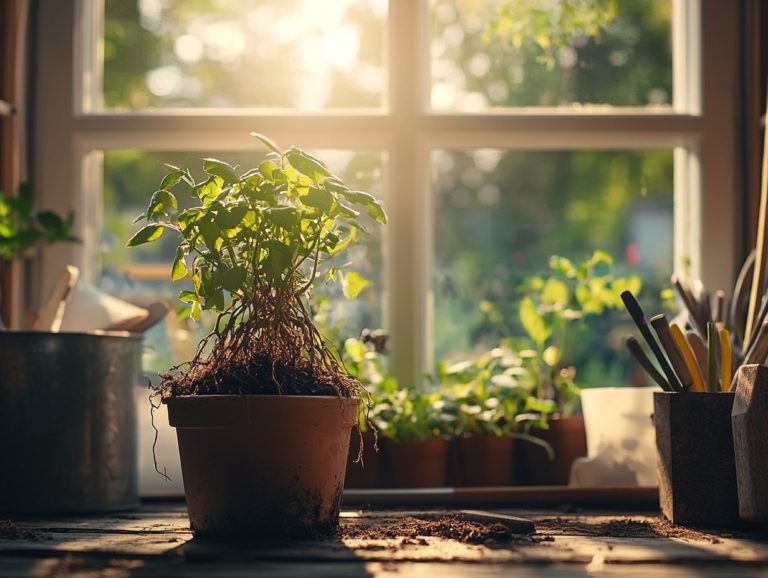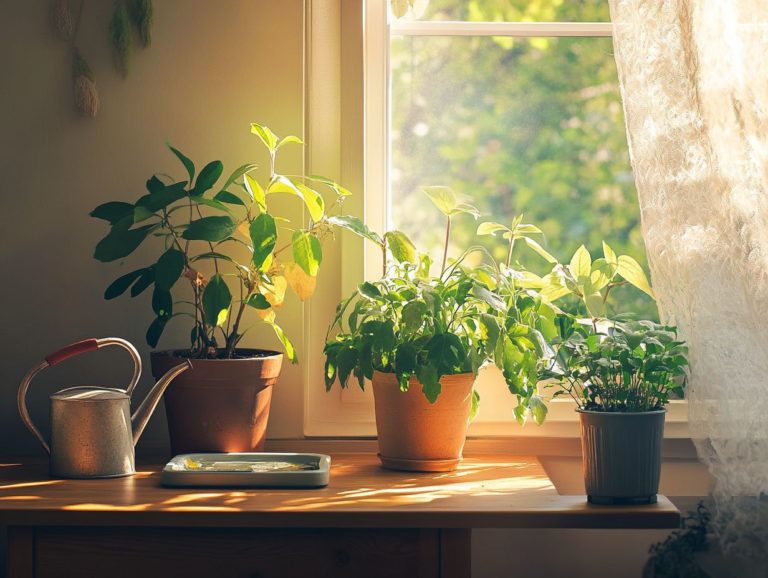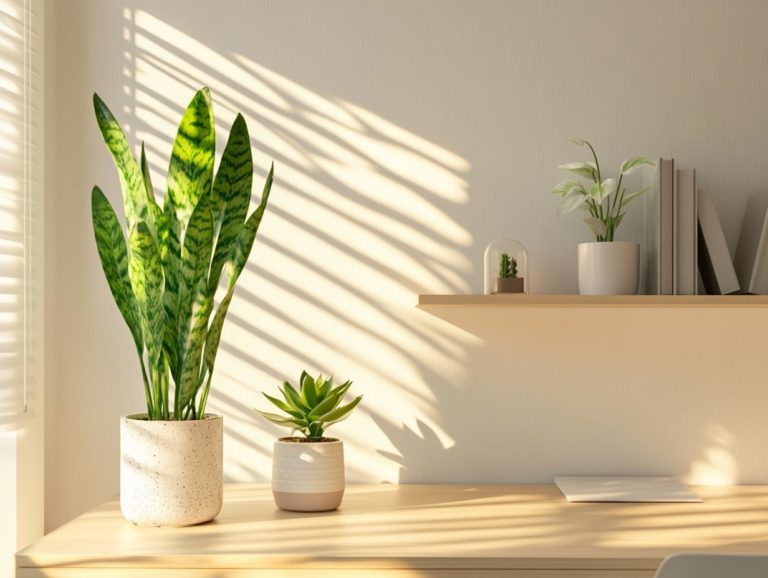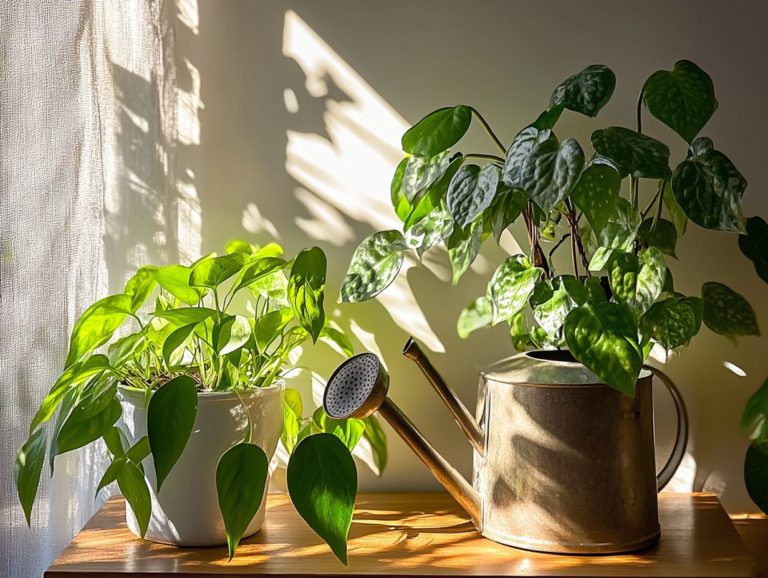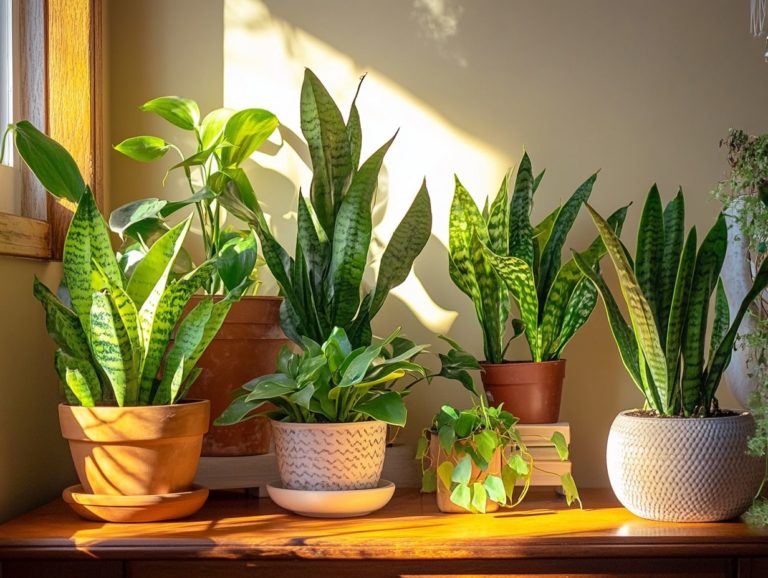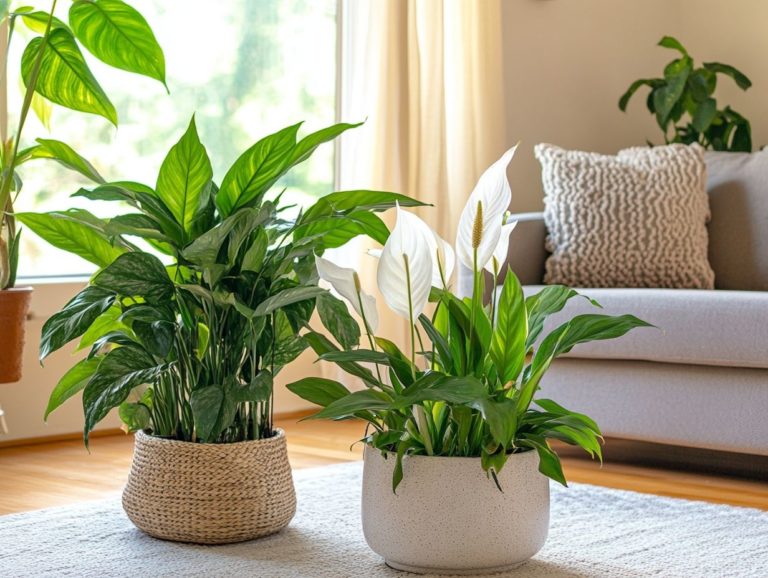What Size Pot is Best for My Indoor Plants?
Choosing the right pot size can make a big difference in your plants’ health, so let’s jump in and find the perfect fit! It is essential for their growth and overall well-being, especially when considering factors like indoor gardening and the specific needs of potted plants.
By grasping the various factors that influence pot selection, such as plant needs and pot requirements, you can appreciate the significant benefits of using the appropriate size.
This guide will walk you through common pot sizes and their specific applications. It will also provide tips for determining your plant’s needs and outline effective techniques for repotting plants, which are essential in plant parenthood.
Discover how the right pot, including options like terracotta pots and ceramic planters, can elevate your indoor garden into a vibrant, thriving oasis!
Contents
- Key Takeaways:
- Choosing the Right Pot Size for Indoor Plants
- Benefits of Using the Proper Pot Size
- Common Pot Sizes for Indoor Plants
- How to Determine the Best Pot Size for Your Plant
- Tips for Repotting and Transplanting
- Frequently Asked Questions
- What Size Pot is Best for My Indoor Plants? Choosing the right size is key to successful indoor plant care.
- How do I determine the right pot size for my indoor plants based on their container needs?
- Is it better to have a smaller or larger pot for my indoor plants to provide optimal growing conditions?
- Can I use a pot that is too big for my indoor plant, and what are the drainage requirements?
- Are there any plants, like succulents and herbs, that require a specific pot size?
- Do I need to repot my indoor plants as they grow, and what are the best pot-picking pointers?
Key Takeaways:
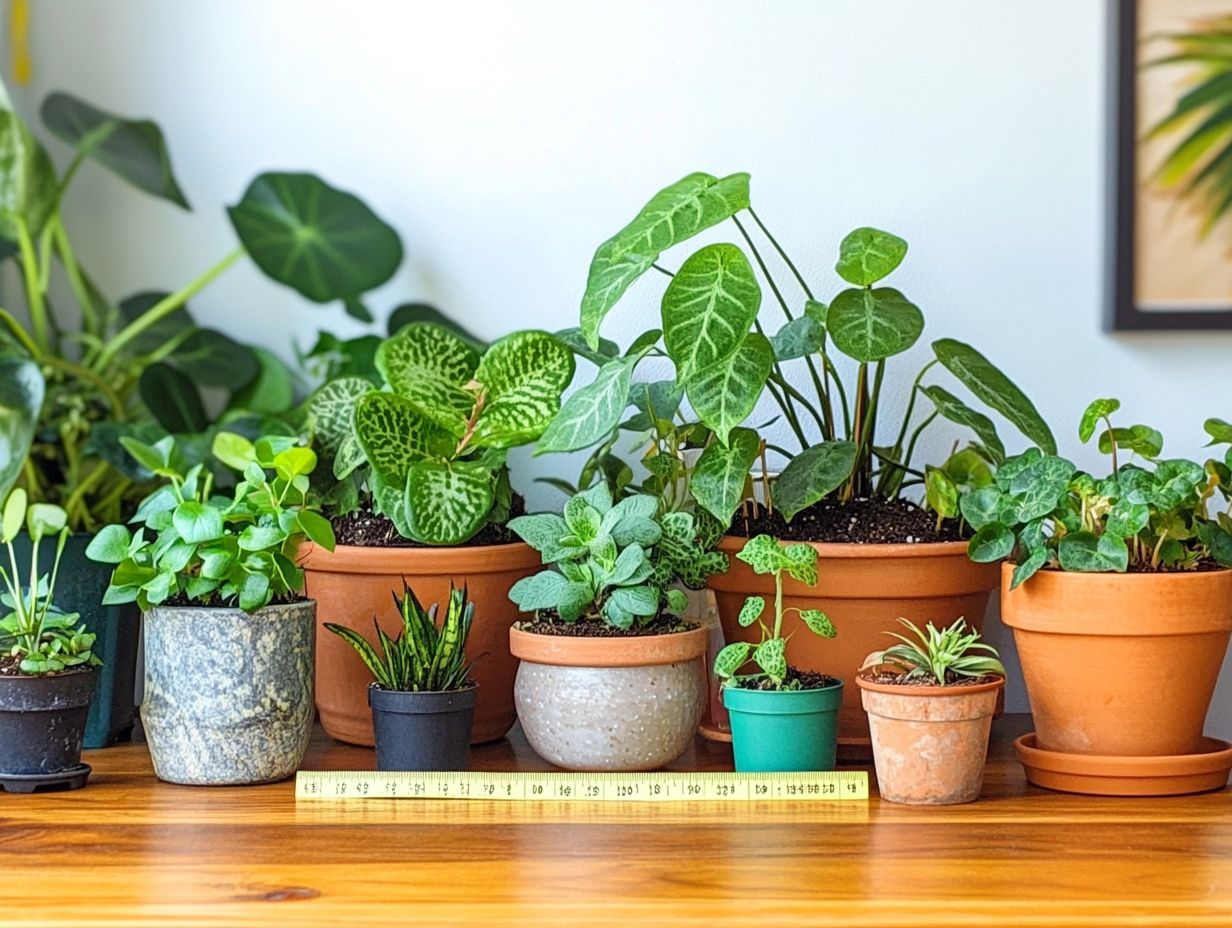
- The right pot size depends on the plant’s size, growth rate, and root system.
- Using the proper pot size allows for optimal growth and health of your plants while preventing problems like being root-bound and overwatering from poor drainage.
- To determine the best pot size, measure your plant’s needs against basic potting rules and consider drainage, space, and future growth. Proper repotting techniques are also important for successful transplanting and maintaining moisture levels.
Choosing the Right Pot Size for Indoor Plants
Selecting the perfect pot size for your indoor plants is a vital choice that can profoundly influence your gardening experience, especially in your journey as a plant parent. The right pot not only fosters healthy growth but also enhances your home s aesthetic appeal.
You ll want to consider factors such as the type of plant you have, its root system, and its drainage needs to ensure optimal growth. Furthermore, understanding basic potting rules is essential; the materials used for your pots should help maintain moisture without the risk of overpotting. Overpotting happens when a pot is too large for the plant, leading to excess soil that retains too much water.
This careful selection boosts the life and beauty of your plants.
Factors to Consider
In terms of selecting the right pot size for your indoor plants, several crucial factors deserve your attention. You need to consider both the specific needs of the plants and the pot needs that will create optimal growing conditions.
Understanding pot diameter is key; it directly affects root growth and moisture retention. A wider pot allows for a more extensive root mass, making it ideal for larger plants like rubber trees. Smaller pots are perfectly suited for succulents, which thrive with compact root systems.
Weight plays a significant role as well; heavier pots can provide the stability needed for tall plants, minimizing the risk of them toppling over.
Proper drainage is crucial to prevent waterlogging, which can be harmful to species like orchids that prefer drier conditions. For a balanced approach, opt for pots with drainage holes and use soil mixes tailored to the moisture needs of your selected plants. This thoughtful strategy will help you create a thriving indoor garden.
Benefits of Using the Proper Pot Size
Utilizing the proper pot size for your indoor plants brings a wealth of benefits that significantly enhance their overall well-being, ensuring optimal growth and vitality. When you select a well-suited pot, you create an ideal environment for your plants, allowing their root systems to thrive while preventing issues like root rot that can arise from insufficient space or poor drainage.
Moreover, choosing the right pot size complements your indoor gardening endeavors by ensuring effective utilization of water and nutrients, ultimately supporting various plant types in reaching their fullest potential.
Optimal Growth and Health for Plants
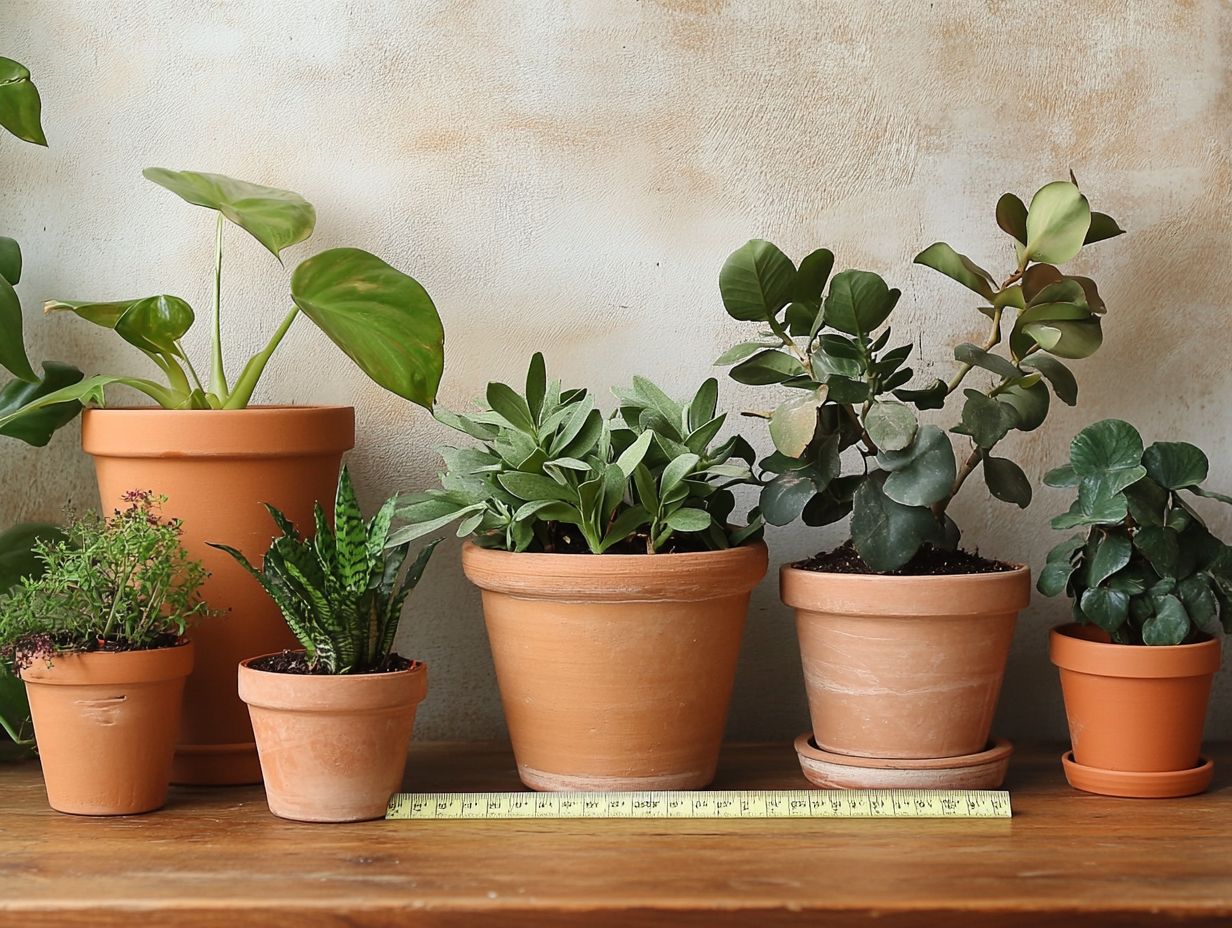
Optimal growth and health for your indoor plants depend heavily on several factors. Pot size is crucial for how well your plants can adapt and flourish, especially in maintaining moisture levels.
Choosing the right pot size gives your plants the space they need for their roots to spread out. This space is vital for nutrient absorption and overall growth.
A well-designed drainage system is also important, allowing excess water to escape and preventing root rot, a common issue for indoor plants.
When your pot is appropriately sized, it helps maintain balanced moisture levels. This ensures just the right amount of water retention without drowning the roots.
This harmonious environment is essential; it directly impacts your plant’s vitality, enabling it to absorb oxygen and nutrients efficiently. It also bolsters its resilience against pests and diseases.
Common Pot Sizes for Indoor Plants
Choosing the right pot size can transform your indoor garden into a thriving oasis! Understanding common pot sizes for indoor plants is crucial for ensuring your gardening endeavors result in beautiful, healthy specimens.
Different plants have distinct container requirements that align with fundamental potting principles, making careful selection of pots essential.
Whether you re opting for small succulent pots or larger, decorative containers for indoor vegetables or herbs, the size and style of the pot should harmonize with both the plant’s needs and your home s aesthetics.
By selecting the right pot size, you not only enhance the visual appeal of your space but also cater to the unique requirements of each plant type. This fosters a thriving indoor garden.
Overview of Different Sizes and Uses
Understanding the different pot sizes and their specific uses is essential for anyone looking to elevate their indoor gardening experience. This is especially important when selecting pots for various potted plants.
Choosing the right pot size can have a profound impact on the growth and health of your plants. Small pots, typically 4 to 6 inches in diameter, are ideal for seedlings and small succulents that flourish in compact spaces.
Medium pots, ranging from 8 to 12 inches, are perfect for houseplants like pothos and peace lilies. They offer ample room for root expansion while keeping moisture levels just right.
For larger plants, consider pots over 12 inches, which accommodate specimens like fiddle-leaf figs or rubber trees. These provide plenty of soil volume and moisture retention.
Don t let your plants suffer! Proper drainage holes are crucial for all pot sizes to prevent potential issues such as root rot. These holes allow excess water to escape, preventing overwatering and ensuring that each plant receives the ideal balance of hydration necessary for thriving growth.
How to Determine the Best Pot Size for Your Plant
Determining the ideal pot size for your plant requires a thoughtful assessment of its unique needs, such as the root system, growth stage, and moisture requirements. Utilizing pot-picking pointers can greatly streamline this process.
By comparing your plant’s size against various pot options, you can make informed decisions for successful plant care. Take into account the type of potting mix and understand the distinctions between nursery pots and decorative pots.
This will help you create the perfect environment for your indoor plants to flourish.
Measuring and Understanding What Your Plant Needs

Measuring and understanding your plant’s needs is essential in choosing the perfect pot size. This choice directly impacts its growth and overall health, allowing for optimal plant selection.
To accurately assess your plant’s size, grab a ruler or measuring tape to determine its height and width.
Don’t forget to check the root system by gently removing it from its current pot. This allows you to evaluate its overall health and density. Observing the roots provides valuable insights into their health and density, which is crucial for selecting a pot that allows for ample growth.
Using the right potting techniques, such as pots with drainage holes and a well-draining soil mix, can significantly enhance root health. By balancing these elements, you ensure that the chosen pot accommodates your plant’s current size while allowing for future growth, setting the stage for a healthy plant.
Tips for Repotting and Transplanting
Repotting and transplanting are vital techniques in plant care that enable your indoor plants to flourish as they mature. By mastering the proper methods, you can make the process seamless and effective, ensuring your greenery remains vibrant and healthy.
Proper Techniques for Moving Plants to Larger Pots
When you move plants to larger pots, using proper techniques is crucial to ensure the transition fosters healthy growth and retains adequate moisture.
To start, gently remove the plant from its original container, being careful not to disturb the root mass too much. You can do this by lightly squeezing the sides of the pot or using a trowel to loosen any compacted soil.
Once the plant is freed, take a moment to inspect the roots for any signs of rot or damage. Trim away any unhealthy portions to encourage rejuvenation and support the overall vitality of your plant.
When placing the plant into its new pot, ensure it is positioned at the same depth as before; this is vital for both stability and proper growth orientation.
Fill the pot with a well-draining potting mix to help maintain moisture levels while preventing waterlogging, which can be detrimental to your plant s health.
Regularly check the soil moisture in the initial weeks after repotting to gauge how well your plant is adapting to its new environment.
Frequently Asked Questions
What Size Pot is Best for My Indoor Plants? Choosing the right size is key to successful indoor plant care.

Wondering what size pot your indoor plant needs? The best pot size depends on several factors, such as the type of plant and its current size. Choosing the right size is crucial for the proper growth and health of your plant.
How do I determine the right pot size for my indoor plants based on their container needs?
One way to find the right pot size is to measure the diameter of the plant’s root ball and select a pot that is 2-3 inches larger. Also, consider the height of the plant and choose a pot that is 1-2 inches deeper than the current pot.
Is it better to have a smaller or larger pot for my indoor plants to provide optimal growing conditions?
In general, having a pot that is slightly larger than the current one is better. This allows the plant’s roots to grow and prevents them from becoming root-bound.
Can I use a pot that is too big for my indoor plant, and what are the drainage requirements?
Using a pot that is too big for your indoor plant can be harmful. The excess soil can retain too much moisture and lead to root rot. It s essential to choose a pot that is appropriately sized for your plant’s needs.
Are there any plants, like succulents and herbs, that require a specific pot size?
Yes, some plants have specific pot size requirements. For example, succulents prefer shallow and wide pots, while plants with deep roots, like tomato plants, require deeper pots. Researching the specific needs of your plant before choosing a pot size is important.
Do I need to repot my indoor plants as they grow, and what are the best pot-picking pointers?
Yes, repot your indoor plants as they grow. This gives their roots enough space to spread and absorb nutrients.
Inspect the plant’s roots every 1-2 years. If they look crowded, it s time to repot.

